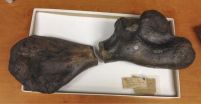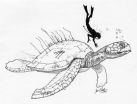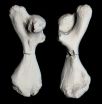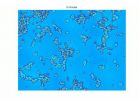(Press-News.org) PHILADELPHIA (Mar. 25, 2014)— "As soon as those two halves came together, like puzzle pieces, you knew it," said Ted Daeschler, PhD, associate curator of vertebrate zoology and vice president for collections at the Academy of Natural Sciences of Drexel University.
That surprising puzzle assembly occurred in the fall of 2012, when Jason Schein, assistant curator of natural history at the New Jersey State Museum, visited the Academy's research collections to better identify and describe a recently-unearthed fossil. The discovery linked scientists from both museums to their predecessors from the 19th century, while setting the stage to advance science today.
The partial fossil bone that Schein had brought to the Academy was a recent discovery by amateur paleontologist Gregory Harpel. Harpel thought the bone seemed strange and out of place when he noticed it on a grassy embankment, a bit upstream from his usual fossil-hunting haunt at a brook in Monmouth County, N.J. Visiting the brook to search for fossil shark teeth is a weekend hobby for Harpel, an analytical chemist from Oreland, Pa. "I picked it up and thought it was a rock at first – it was heavy," Harpel said.
When he realized it was indeed a fossil, certainly much larger and possibly a lot more scientifically significant than shark teeth, he took it to the experts at the New Jersey State Museum, to which he ultimately donated his find.
Schein and David Parris, the museum's curator of natural history, immediately recognized the fossil as a humerus – the large upper arm bone – from a turtle, but its shaft was broken so that only the distal end, or end nearest to the elbow, remained.
Parris also thought the fossil looked extremely familiar. He joked with Schein that perhaps it was the missing half of a different large, partial turtle limb housed in the collections at the Academy of Natural Sciences of Drexel University. That bone also had a broken shaft, but only its proximal end, nearest to the shoulder, remained. The coincidence was striking.
"I didn't think there was any chance in the world they would actually fit," Schein said.
That's because the Academy's piece of the puzzle was much too old, according to the conventional wisdom of paleontology. Paleontologists expect that fossils found in exposed strata of rock will break down from exposure to the elements if they aren't collected and preserved, at least within a few years-- decades at the most. There was no reason to think a lost half of the same old bone would survive, intact and exposed, in a New Jersey streambed from at least the time of the old bone's first scientific description in 1849, until Harpel found it in 2012.
The Academy's older bone was also without a match of any kind, making a perfect match seem even more farfetched: It was originally named and described by famed 19th-century naturalist Louis Agassiz as the first, or type specimen, of its genus and species, Atlantochelys mortoni. In the intervening years, it remained the only known fossil specimen from that genus and species.
It remained so until that fateful day when Schein carried the "new" New Jersey fossil to the Academy in Philadelphia, connecting the two halves. The perfect fit between the fossils left little space for doubt. Stunned by the implications, Schein and Academy paleontology staffers Jason Poole and Ned Gilmore, who had assembled the puzzle together, called Daeschler into the room.
"Sure enough, you have two halves of the same bone, the same individual of this giant sea turtle," said Daeschler. "One half was collected at least 162 years before the other half."
Now, the scientists are revising their conventional wisdom to say that, sometimes, exposed fossils can survive longer than previously thought. They report their remarkable discovery in the forthcoming 2014 issue of the Proceedings of the Academy of Natural Sciences of Philadelphia. The find is also featured in the April 2014 issue of National Geographic magazine, on newsstands now.
"The astounding confluence of events that had to have happened for this to be true is just unbelievable, and probably completely unprecedented in paleontology," said Schein.
The fully assembled A. mortoni humerus now gives the scientists more information about the massive sea turtle it came from as well. With a complete limb, they have calculated the animal's overall size – about 10 feet from tip to tail, making it one of the largest sea turtles ever known. The species may have resembled modern loggerhead turtles, but was much larger than any sea turtle species alive today.
The scientists believe that the entire unbroken bone was originally embedded in sediment during the Cretaceous Period, 70 to 75 million years ago, when the turtle lived and died. Then those sediments eroded and the bone fractured millions of years later during the Pleistocene or Holocene, before the bone pieces became embedded in sediments and protected from further deterioration for perhaps a few thousand more years until their discovery.
INFORMATION:
Video: https://www.youtube.com/watch?v=9ORrJCt-2KA
News media contact:
Rachel Ewing, News Officer, Office of University Communications, Drexel University
215-895-2614 (office), 215-298-4600 (cell), raewing@drexel.edu
Carolyn Belardo, Senior Communications Manager, The Academy of Natural Sciences of Drexel University
215-299-1043, belardo@ansp.org
Susan Greitz, Marketing Coordinator, NJ State Museum
609-292-6308, susan.greitz@sos.state.nj.us
About the Academy of Natural Sciences of Drexel University
Founded in 1812, the Academy of Natural Sciences of Drexel University is a leading natural history museum dedicated to advancing research, education, and public engagement in biodiversity and environmental science. The museum, at 1900 Benjamin Franklin Pkwy., Philadelphia, is open from 10 a.m. to 4:30 p.m. Monday through Friday and 10 a.m. to 5 p.m. Saturday and Sunday. For more information, call 215-299-1000 or visit ansp.org.
About the New Jersey State Museum
Established in 1895, the New Jersey State Museums serves the life-long educational needs of residents and visitors through its collections, exhibitions, programs, publications and scholarships in science, history and the arts. Within a broad context, the Museum explores the natural and cultural diversity of New Jersey, past and present.
The New Jersey State Museum, located at 205 West State Street in Trenton, is open Tuesday through Sunday from 9 am to 4:45 pm. The Museum is closed Mondays and all state holidays. The NJ State Museum has a "suggested" admission fee. Admission fee revenue supports the Museum's collections, exhibitions and programs.
For more information, please visit the Museum's website at http://www.statemuseum.nj.gov or call the recorded information line at (609) 292-6464. On weekends, free parking is available in lots adjacent to and behind the Museum. Please visit http://www.trentonparking.com for a number of options for parking in downtown Trenton during the week.
Paleontologists assemble giant turtle bone from fossil discoveries made centuries apart
2014-03-25
ELSE PRESS RELEASES FROM THIS DATE:
Recreational drug users who switch from ecstasy to mephedrone don't understand the dangers
2014-03-25
Contrary to popular belief among recreational drug users, mephedrone has several important differences when compared with MDMA, commonly known as ecstasy. These differences mean that mephedrone could leave a user with acute withdrawal symptoms and indicate that it may have a higher potential for developing dependence than MDMA according to a study published in British Journal of Pharmacology.
"Although users report that mephedrone produces similar psychoactive effects to MDMA, these two drugs produce different changes in the brain and the adverse effects they produce, ...
Mentally challenging jobs may keep your mind sharp long after retirement
2014-03-25
ANN ARBOR—A mentally demanding job may stress you out today but can provide important benefits after you retire, according to a new study.
"Based on data spanning 18 years, our study suggests that certain kinds of challenging jobs have the potential to enhance and protect workers' mental functioning in later life," said Gwenith Fisher, a faculty associate at the University of Michigan Institute for Social Research and assistant professor of psychology at Colorado State University.
The research analyzed data on 4,182 participants in the U-M Health and Retirement Study, ...
New discovery finds missing hormone in birds
2014-03-24
How does the Arctic tern (a sea bird) fly more than 80,000 miles in its roundtrip North Pole-to-South Pole migration? How does the Emperor penguin incubate eggs for months during the Antarctic winter without eating? How does the Rufous hummingbird, which weighs less than a nickel, migrate from British Columbia to Mexico? These physiological gymnastics would usually be influenced by leptin, the hormone that regulates body fat storage, metabolism and appetite. However, leptin has gone missing in birds - until now.
University of Akron researchers have discovered leptin ...
Research reveals new depths of complexity in nerve cells
2014-03-24
Research from the Oklahoma Medical Research Foundation reveals a new complexity to nerve cells in the brain that could affect future therapies aimed at altering mood and memory in humans.
OMRF scientist Kenneth Miller, Ph.D., studied the function of a common protein (known as CaM Kinase II) in tiny roundworms called C. elegans. His research appears in the latest issue of the journal Genetics.
"CaM Kinase II is very abundant in the brain, so it has been heavily studied," Miller said. "But this is the first time anybody has seen results like this."
Using a method ...
New technique sheds light on human neural networks
2014-03-24
VIDEO:
Using spatial light interference microscopy (SLIM) techniques developed by Gabriel Popescu, director of the Quantitative Light Imaging Laboratory at the Beckman Institute at the University of Illinois, researchers were able...
Click here for more information.
A new technique, developed by researchers in the Quantitative Light Imaging Laboratory at the Beckman Institute at the University of Illinois, provides a method to noninvasively measure human neural networks in ...
Life lessons: Children learn aggressive ways of thinking from violent video games
2014-03-24
AMES, Iowa – Children who repeatedly play violent video games are learning thought patterns that will stick with them and influence behaviors as they grow older, according to a new study by Iowa State University researchers. The effect is the same regardless of age, gender or culture. Douglas Gentile, an associate professor of psychology and lead author of the study published in JAMA Pediatrics, says it is really no different than learning math or to play the piano.
"If you practice over and over, you have that knowledge in your head. The fact that you haven't played ...
Obamacare: 42 percent of Americans can't explain a deductible
2014-03-24
The week before open enrollment closes for new health care exchanges, a study by researchers at the USC Schaeffer Center for Health Policy and Economics and the USC Dornsife Center for Economic and Social Research shows that those who might potentially benefit the most from the Affordable Care Act — including those earning near the Federal Poverty Level — are also the most clueless about health care policies.
The opening of health care exchanges last year was roiled in controversy over technical glitches. Obamacare has since enrolled more than 5 million people, according ...
One in 10 male, same-sex Craigslist ads seek men who don't identify as gay
2014-03-24
March 24, 2014 -- Online sexual hook-ups present a unique opportunity to explore many factors of decision-making that inform sexual health. A study conducted by Eric Schrimshaw, PhD, at Columbia University's Mailman School of Public Health and Martin J. Downing, Jr., PhD, of the National Development and Research Institutes, found evidence that men having sex with men use the Internet to find sexual partners who do not identify as gay, either to fulfill a fantasy or because it allows anonymous sexual encounters without discovery. The findings are online in the journal, ...
Adult day-care services boost beneficial stress hormones in caregivers
2014-03-24
Family caregivers show an increase in the beneficial stress hormone DHEA-S on days when they use an adult day care service for their relatives with dementia, according to researchers at Penn State and the University of Texas at Austin.
DHEA-S controls the harmful effects of cortisol and is associated with better long-term health.
"This is one of the first studies to show that DHEA-S can be modified by an intervention, which in our case, was the use of an adult day care service," said Steven Zarit, Distinguished Professor of Human Development and Family Studies, Penn ...
Parallel programming may not be so daunting
2014-03-24
Computer chips have stopped getting faster: The regular performance improvements we've come to expect are now the result of chipmakers' adding more cores, or processing units, to their chips, rather than increasing their clock speed.
In theory, doubling the number of cores doubles the chip's efficiency, but splitting up computations so that they run efficiently in parallel isn't easy. On the other hand, say a trio of computer scientists from MIT, Israel's Technion, and Microsoft Research, neither is it as hard as had been feared.
Commercial software developers writing ...




